How to Make Turns: U-Turn, Left Turn, Right Turn and Rules
Learning how to make turns correctly and safely is a big part of driving – you can’t make a trip anywhere without turning. In this article, we’ll go through all you need to know about turning, including:
- Left Turns
- Right Turns
- U-turns
- Preparing to Turn
Mục Lục
How to Make a Safe Turn in 8 Steps
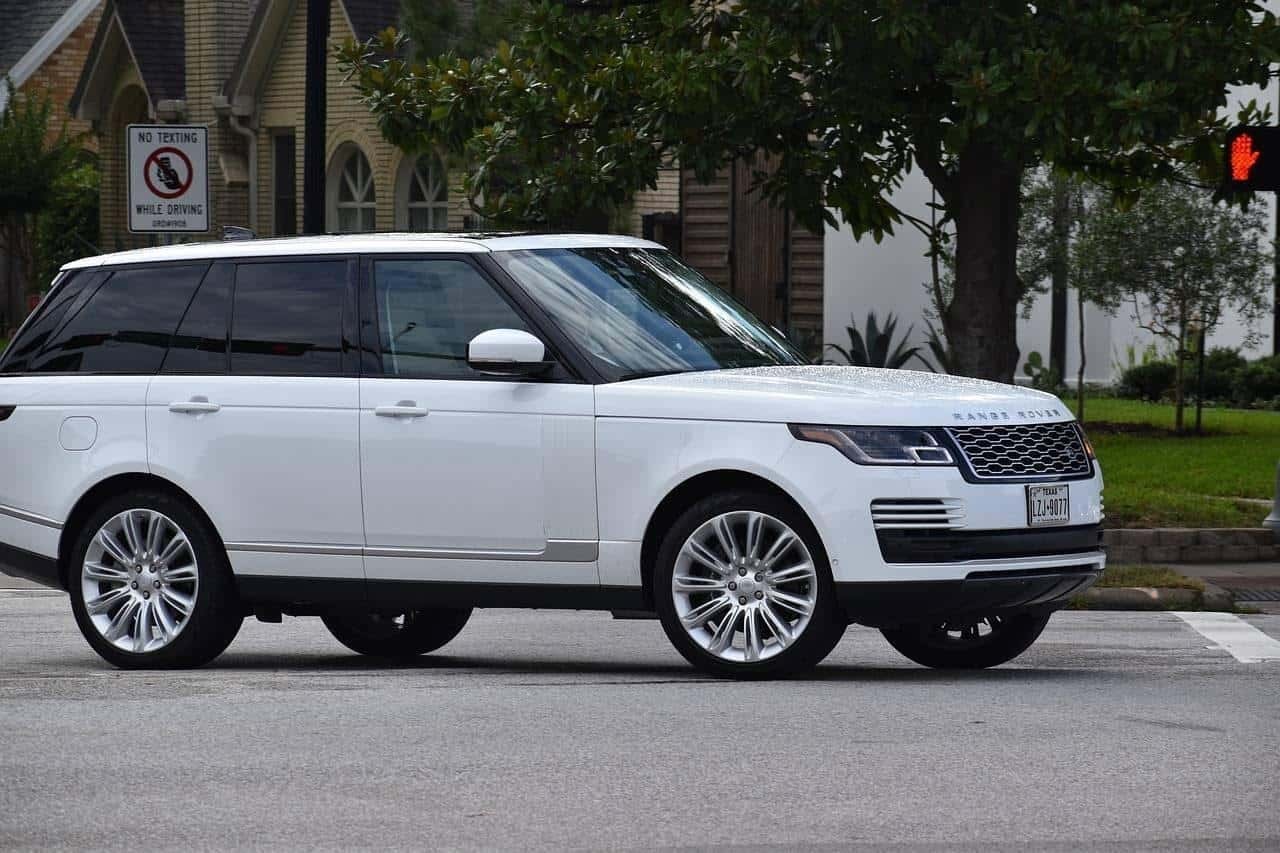 Turn safely at intersections using the right-of-way rules
Turn safely at intersections using the right-of-way rules
Follow these 8 steps to make the perfect turn at an intersection:
- Check your rear-view mirror for any tailgaters (drivers dangerously close to the rear of your vehicle)
- Check your side mirrors for other vehicles, cyclists, and pedestrians.
- Check your blind spots by physically turning your body.
- Activate your turn signal at least 100 feet before turning.
- Position yourself in the correct lane before reaching the turning point.
- Slow down to a safe turning speed. Obey traffic signs and turn signals on the road you are about to enter.
- Look to both sides before proceeding. Only turn when safe and yield to any pedestrians.
- Finish your turn in the correct lane.
The Four Main Types of Turns
There are four main types of turns you can make while on the road:
- Left Turn
- Right Turn
- Three-Point Turn
- U-Turn
We will go through each type of turn, giving examples with tips for turning safely.
Be aware that the rules may vary slightly from state to state. So check the specific rules in your state driver’shandbook.
How to Make Left Turns at Intersections
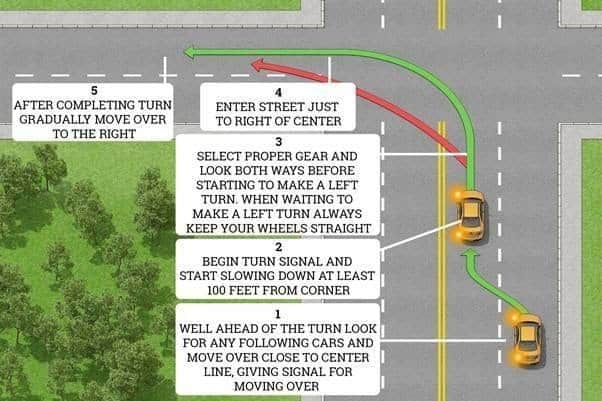
General rules on how to safely make left turns in 5 simple steps:
- Position your vehicle as close as possible to the left towards the center lane
- Turn on your left turn signal and start slowing down at least 100 feet from the corner
- Look to both sides before proceeding. Check your left blind spot to ensure there are cyclists, or pedestrians in the vicinity.
- Only turn when safe, entering just right of the center. Don’t cut the corner as it might lead to a collision with oncoming vehicles
- After completing the turn, gradually move over to the right and straight your wheels.
Tip: Keep your wheels straight until you are about to make your turn. Otherwise, a vehicle crashing into your rear could push your vehicle into the path of oncoming traffic.
Other Examples of Left Turns
Turning left from a two-way street
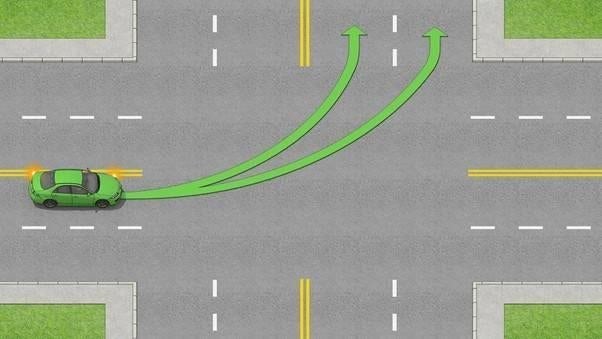
- Position your vehicle in the left lane closest to the middle of the street
- If arrows or signs permit, you may turn from another lane
- When turning, you may enter either lane in the cross street (if safe)
- If there is a center left turn lane, you must use it.
Turning left from a two-way street into a one-way street
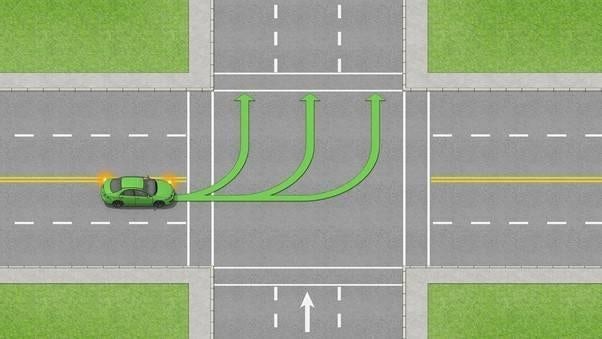
- Position your vehicle in the left lane closest to the middle of the street
- Turn into any lane (if safe)
Turning left from a one-way street into a two-way street
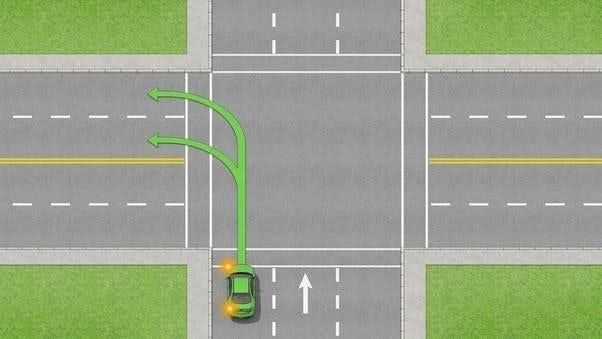
- Position your vehicle in the far-left lane
- Turn into any lane (if safe)
How to Make Right Turns at Intersections
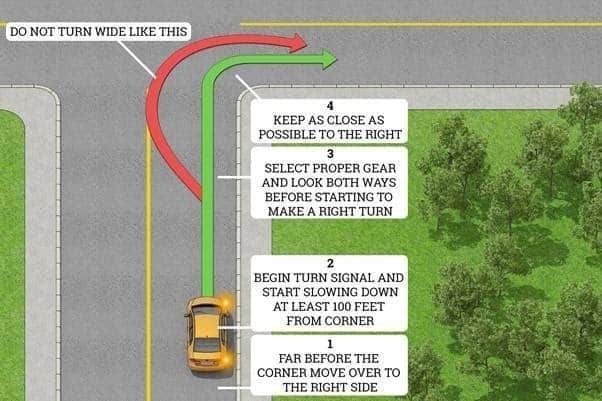
How to safely make a right turn in 4 simple steps:
- Position your vehicle close to the right edge of the road.
- Watch for pedestrians and cyclists to your right that could be injured in the turn
- Look to both sides before proceeding. Only turn when safe
- Do not turn too wide as you risk colliding with traffic traveling in the opposite direction
Examples of Right Turns
Turning right from a two-way street
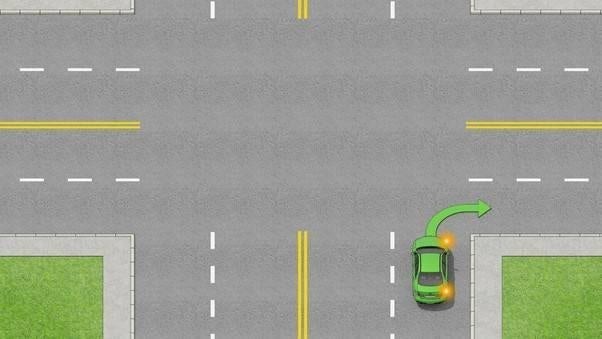
- Position your vehicle in the far right lane
- If arrows or signs permit, you may turn from another lane
- Turn into the lane nearest to the edge of the road – make sure that you don’t turn too wide into another lane
- Be alert and look for motorcyclists, cyclists, and pedestrians.
Three-Point Turn
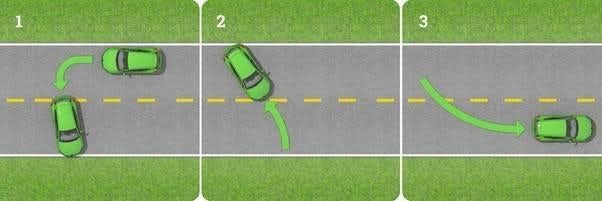
Three-point turns can be used to make a turn on a road that isn’t wide enough for you to make a U-turn.
Here are the five steps for making a three-point turn:
- Signal and pull over to the right side of the road
- Signal left and wait until clear of traffic
- When clear of traffic and safe to turn, turn left across the road all the way to the curb
- Turn the steering wheel all the way to the right, and then reverse to the curb
- Straighten the vehicle by driving forward and move into the correct lane
Tip: Remember to continuously look for traffic while performing a three-point turn. Never perform a three-point turn unless safe or if prohibited.
What is a U-Turn?
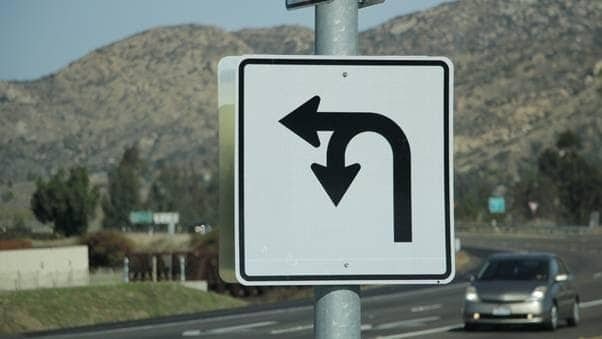
A U-turn refers to making a 180-degree turn to go back the way you came from. When performing a U-turn, use the far-left lane or the center left-turn lane (if one exists). Before you perform a U-turn, you must always make sure that it is safe and legal to do so.
Illegal U-turns
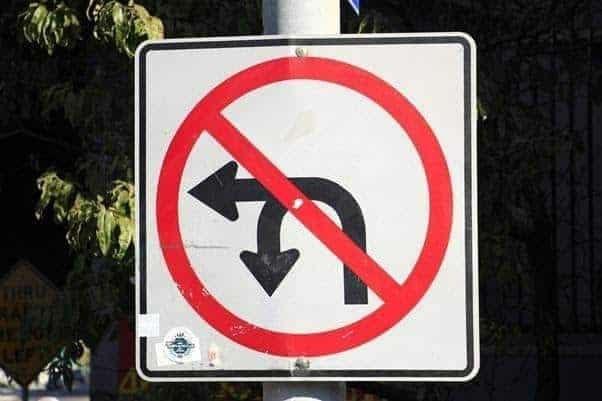
Generally, you are NOT allowed to make a U-turn:
- At a railroad crossing
- If unable to see clearly in each direction (e.g., due to a hill or rain)
- On divided highways, if you have to cross two sets of double yellow lines, a curb, strip of land, or dividing section
- If there is a “No U-turn” sign
- On one-way streets
- If you risk blocking the path of an emergency vehicle e.g., in front of a fire station
Don’t make a U-turn if a dangerous situation could arise while performing the turn. Performing an illegal U-turn is a traffic violation. Make sure to check the specific rules for your state so you know all the situations when it’s illegal to make a U-turn.
U-turns are dangerous, so avoid performing one unless necessary. Instead of a U-turn, try turning around by driving around the block or using parking lots or driveways.
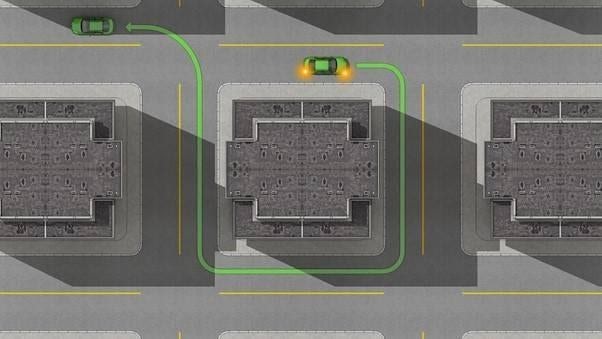 Sometimes it’s better to go around the block than risk a U-turn
Sometimes it’s better to go around the block than risk a U-turn
If you prefer video, we have an explainer video lesson on making 3-point turns & U-turns.
Preparing to Turn
Preparing to turn is important. Position yourself in the correct lane for your turn well in advance and use your turn signals to warn other road users of your intention to turn. Be careful and try to make eye contact with other road users and pedestrians.
Keep in mind that everyone mistakes, so never assume that other road users will yield just because they should or because they are signaling. Wait for an additional indication that the other road user will yield such as by signaling AND slowing down.
In the following example, the red cars aren’t correctly positioned for their respective turns and risk colliding with each other. The green cars are turning from the correct lane.
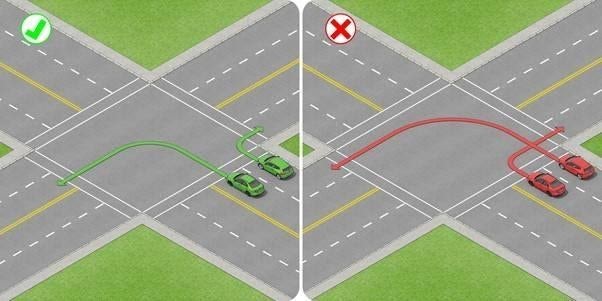 Green cars are positioned to make the correct left turn and right turn. The red cars are not.
Green cars are positioned to make the correct left turn and right turn. The red cars are not.
Avoid Last-Minute Decisions
If you have started to cross an intersection or started making a turn, follow through rather than change direction at the last minute. Make a safe turn elsewhere.
If you are in the wrong lane when you reach the turning point, keep driving, and take the next available exit/turn.
Remember That You’re Sharing the Road
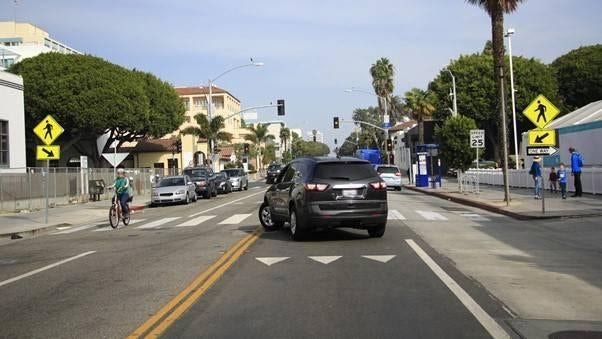 Sharing the road using right-of-way rules at an intersection
Sharing the road using right-of-way rules at an intersection
Sharing the road means turning while paying attention to cyclists and pedestrians crossing.
Motorcyclists, bicyclists, and pedestrians are especially difficult to spot. To avoid accidents when turning you should:
- Look for cyclists in a bicycle lane or near the edge of the road before you turn. Don’t cut them off as the rider can get seriously injured or even die.
- Check both sides for motorcycles before turning.
- Watch out for pedestrians on or about to cross the road when you are turning.















![Toni Kroos là ai? [ sự thật về tiểu sử đầy đủ Toni Kroos ]](https://evbn.org/wp-content/uploads/New-Project-6635-1671934592.jpg)


